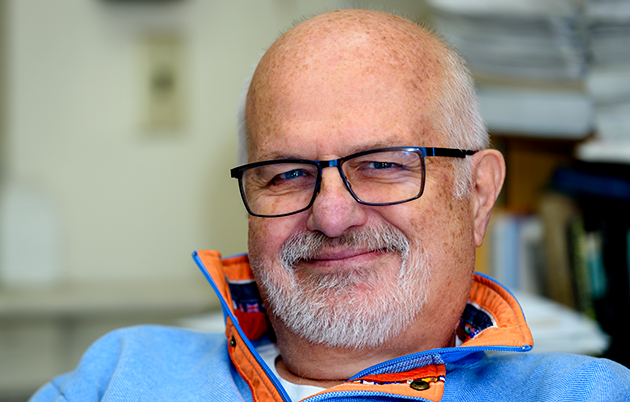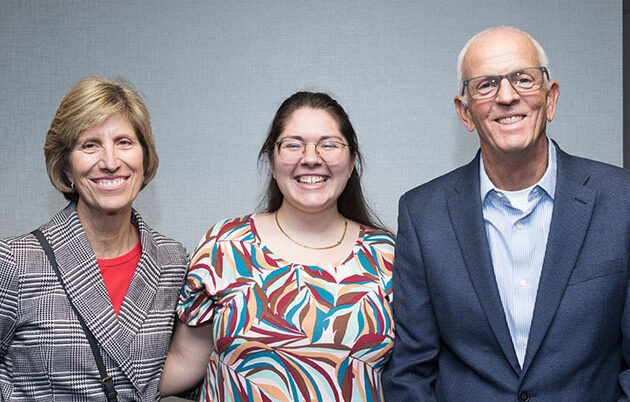Improving Babies’ Quality of Life

When she joined the University of Wisconsin School of Medicine and Public Health’s Department of Surgery in late 2021, Inna Lobeck, MD, had been recruited to practice and teach her substantial skills in fetal and pediatric surgery and surgical critical care, and to become the director of the multidisciplinary UW Health Fetal Diagnosis and Treatment Center.
That center, which opened in March 2022, builds upon several clinical programs and facilities, including those in the Department of Obstetrics and Gynecology and Department of Pediatrics. For instance, for nearly a decade, the Center for Perinatal Care has been a joint program of UW Health and UnityPoint Health–Meriter Hospital; it is housed at the latter. The perinatal center provides intensive care for a wide range of common maternal and neonatal conditions, such as maternal diabetes, throughout a pregnancy. The Fetal Diagnosis and Treatment Center works in tandem with that center.
Comprising a large cohort of multidisciplinary experts, the Fetal Diagnosis and Treatment Center’s primary purpose is to diagnose and create treatment plans for unborn babies with serious surgical conditions. Its fetal interventions include surgery before, during, or after birth.
Filling an Unmet Need
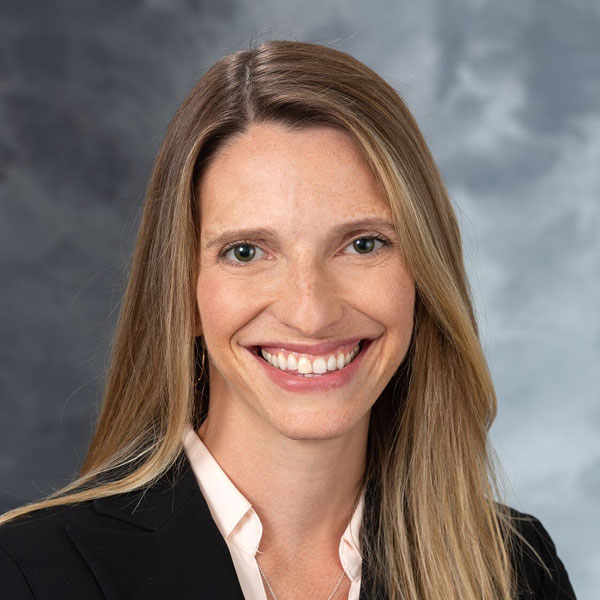
When the Fetal Diagnosis and Treatment Center opened, Lobeck expected a slow, steady stream of new patients — but demand far outpaced anyone’s predictions.
“Nobody realized what an impact the center would have for Wisconsin and surrounding states,” says Lobeck, now an assistant professor of surgery. “From the beginning, we have had a large influx of referrals from places like Green Bay, Appleton, and La Crosse, Wisconsin; Rockford, Illinois; and parts of Iowa. This feels like an example of ‘If you build it, they will come.’”
Wisconsin’s occurrence of birth defects in pregnancies is similar to the national average of about 3 percent. Thus, with 60,000 or more births per year in the state, approximately 2,000 pregnancies result in a fetus with a birth defect that requires care. Some such conditions are serious, and some now can be treated at UW Health before birth, preventing the need for physicians to refer their patients to out-of-state facilities.
Offering Surgical Options
Fetal surgery is relatively new — the first open fetal surgery to repair a congenital urinary tract blockage was performed at the University of California, San Francisco (UCSF) in 1981. Over the next 30 years, many procedures were introduced, all intended to save the life of the fetus. In the last decade — with the advent of new knowledge, technologies, and procedures — fetal surgery specialists are using their expertise to improve babies’ quality of life through more in utero treatments. For example, an eight-year clinical trial at UCSF showed in 2011 that fetal intervention for the most serious form of spina bifida — myelomeningocele — produced fewer adverse neurological effects and better overall results compared to surgery immediately after birth. Since the UW Health Fetal Diagnosis and Treatment Center opened, its surgeons have repaired two myelomeningoceles before birth.
Thirty years ago, many of these conditions were untreatable and resulted in pregnancy loss or a poor quality of life for the baby. Now we have an opportunity to intervene early and change that.
- Inna Lobeck, MD
The number of fetal anomalies that can be treated through in utero surgery is growing. Often using minimally invasive endoscopic tools and image-guided methods, experts at the Fetal Diagnosis and Treatment Center can address a wide range of conditions, including congenital heart and urinary tract defects, spinal cord anomalies, gastrointestinal and lung defects, airway obstruction, and complex conditions among twins.
“Thirty years ago, many of these conditions were untreatable and resulted in pregnancy loss or a poor quality of life for the baby,” Lobeck explains. “Now we have an opportunity to intervene early and change that.”
Staying Close to Home
Reflecting on the situation before the Fetal Diagnosis and Treatment Center opened, Lobeck notes, “People often aren’t able to travel several hours to get fetal surgery and live away from home through their baby’s birth and time in the neonatal intensive care unit (NICU).”
The center’s multidisciplinary and comprehensive nature mitigates and sometimes eliminates the need for travel and disruption for families.
At the Fetal Diagnosis and Treatment Center, about 50 clinicians represent the fields of fetal surgery; maternal-fetal medicine in obstetrics and gynecology; pediatric surgery, neurosurgery, otolaryngology, urology, and nephrology; neonatology; pediatric cardiac, cardiothoracic, and transplant surgery; maternal and pediatric anesthesiology; radiology; and more.
The center’s large cohort of dedicated personnel offers evaluation, diagnosis, counseling, and plans for surgery all in one place, in a short time. A fetal surgery coordinator guides families from consultation through treatment and aftercare, and supports the family’s transition to home. The center also offers delivery and care after birth, explains Lobeck.
Close communication and collaboration with referring maternal-fetal medicine providers, as well as neonatologists at other hospitals’ NICUs, assure that postnatal protocols are communicated and followed. Lobeck notes that families, referring providers, and other specialists are kept informed through a rigorously supported web of communication.
Saving the Anderla Twins
In August 2022, when Phoebe Anderla was 23 weeks pregnant with twins, she and Chad Anderla called upon experts at the Fetal Diagnosis and Treatment Center. The couple — who live in Menominee, Michigan, and had received ongoing prenatal monitoring by a maternal-fetal medicine physician in Green Bay, Wisconsin — was referred for additional testing at the UW Health Fetal Diagnosis and Treatment Center. There, Lobeck and her colleague Michael Beninati, MD (PG ’20), assistant professor, Department of Obstetrics and Gynecology, Division of Maternal-Fetal Medicine, diagnosed the twins with Stage 3 Twin Anemia Polycythemia Sequence (TAPS). In this rare condition, blood is circulated unevenly between twins, so one becomes anemic while the other receives too much blood and nutrients, causing that twin’s heart to work too hard.
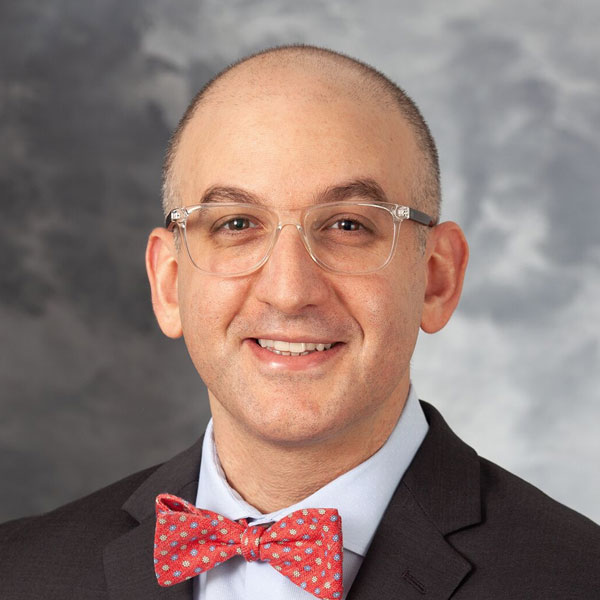
“If it’s not treated, TAPS can be fatal to both twins,” Lobeck says. “The condition is very serious and should be addressed immediately.”
The surgical team operated on Phoebe Anderla and the twins within three hours of the family’s arrival at the center. They employed a procedure called fetoscopic laser ablation, in which the fetal surgeon uses a 2-millimeter scope to see inside the uterus and identify the placental blood vessels that are causing the circulation imbalance, and uses a laser to close the vessels that connect the twins.
“The blood flow between the Anderla twins began normalizing almost immediately,” Lobeck says. “It was the first laser procedure performed at the center, and the surgery was successful.”
The family stayed at UnityPoint Health — Meriter Hospital in Madison for one night before returning home for the rest of their pregnancy. The twins, Carter and Shea, were born in Green Bay and had a brief NICU stay before joining brothers Pierce, age 7, and Camden, age 2, at home.
Phoebe Anderla shares that she and her husband are grateful to Lobeck and the entire care team.
“This feels like a miracle! Our babies needed help, and a center just a few hours away had recently opened that was able to save them,” she exclaims.
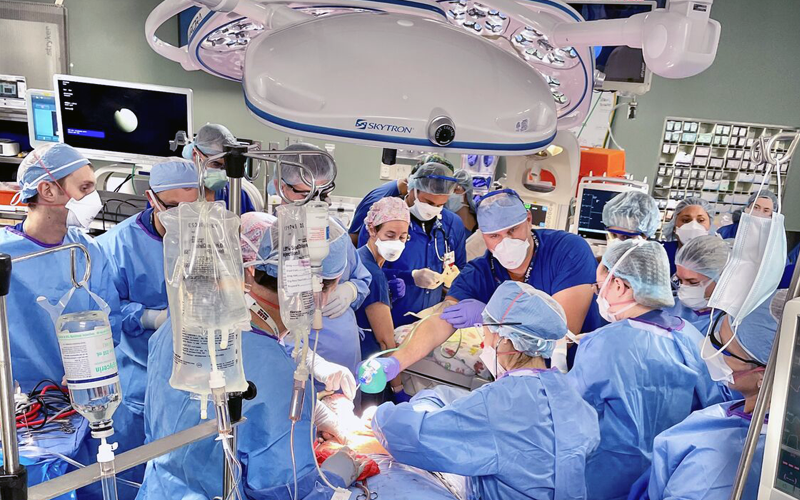
Creating Airways
Lobeck, Beninati, and Michael Puricelli, MD, assistant professor, Department of Surgery, Division of Otolaryngology, have worked as a team at American Family Children’s Hospital to perform the dramatic Ex-Utero Intrapartum Treatment (EXIT) procedure for infants about to be born without a functional airway. Without intervention, these babies would suffocate and die within minutes after birth. The EXIT procedure requires significant expertise, precise timing, and the support of many operating room staff members. This trio of surgeons has successfully performed the procedure three times as of June 2023.
Our goal is to get patients back home, into their support systems, and under their physicians’ care as soon as possible.
- Michael Beninati, MD (PG ’20)
In an EXIT procedure, the baby is partially delivered, with its head exposed while the rest of the body remains inside the mother so the attached placenta can provide oxygen and blood flow. Sometimes, an anomalous mass of tissue needs to be removed before the surgical team can fashion a functional airway. Following surgery, the baby is delivered completely, with a new, functioning airway to fill its lungs.
By offering EXIT procedures and other complex surgeries, the Fetal Diagnosis and Treatment Center has gained the trust of many referring physicians.
“Our goal is to get patients back home, into their support systems, and under their physicians’ care as soon as possible,” Beninati says.
Puricelli adds, “Physicians and nurses in our center are leaders in international efforts to improve pregnancy outcomes. I want other physicians to be aware that pregnant individuals sometimes deliver neonates with the inability to breathe at birth. Our advanced techniques can permit early identification as well as life- and function-preserving interventions to support the best outcomes.”
Repairing Spina Bifida
Raheel Ahmed, MD, PhD, an assistant professor in the Department of Neurological Surgery who trained in pediatric and fetal neurosurgery, has performed fetoscopic repair of spina bifida with Lobeck and Beninati at the Fetal Diagnosis and Treatment Center. He echoes the benefits of having close communication with regional obstetricians, who are the most likely providers to identify serious problems in their patients’ pregnancies.
“There is a narrow window between 19 and 26 weeks of gestation when the spina bifida procedure can occur, and much has to happen in that window,” Ahmed explains, adding that a detailed decision tree can effectively place the patient on the path to fetal treatment. “The patient’s physician must identify the need for attention by 20 weeks and quickly refer her so these complex processes can begin.”
Lobeck explains that in utero spina bifida repair aims to improve the baby’s quality of life after birth because it reduces the need for shunts and increases the likelihood that the baby will be able to walk.
Preparing for Procedures
The center’s nature of collaboration and communication among health care professionals also enhances the work of those whose patients are diagnosed with conditions that cannot be repaired through in utero interventions.
For instance, Rachel Engen, MD, an assistant professor in the Department of Pediatrics’ Division of Nephrology, appreciates how thoroughly her patients are informed about abnormal fetal kidney conditions through early diagnosis at the center.
“Once the baby is born, we see the benefits of prenatal consultation with the Fetal Diagnosis and Treatment Center,” Engen explains. “Parents have time to ask questions, process the answers, and work with providers to create a plan for delivery and postnatal care. This makes the first days after birth much smoother so we can quickly provide effective care.”
Another member of the team — Kelly M. Collins, MD, FACS, an associate professor in the Department of Surgery’s Division of Transplantation and the director of pediatric liver and kidney transplantation at UW Health — praises the work of the Fetal Diagnosis and Treatment Center.
“Dr. Lobeck has been an incredible champion of collaboration among specialty groups, and we are so excited to continue to partner with her and others in the center.”
Noting that expert care after birth is critical for neonates who have had fetal surgery, Jamie Limjoco, MD, MS, MMM, an associate professor in the Department of Pediatrics’ Division of Neonatology and Newborn Nursery, reports that the NICU is much busier since the Fetal Diagnosis and Treatment Center opened.
Limjoco, the medical director of the Level IV NICU at American Family Children’s Hospital, says, “Babies who have had fetal surgery are often born early with unique needs. They can now stay locally rather than having to travel, and this significantly changes the lives of the families since these babies typically have a long NICU stay.”
She continues, “We have a huge ancillary staff of nurses, respiratory therapists, pharmacists, genetic counselors, and others who make this work. I want to say, ‘It takes a village,’ but it’s much larger than that—it takes a world to do what we do. The Fetal Diagnosis and Treatment Center’s collaboration and strong, inclusive communication have been essential to our success.”
